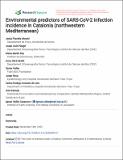Por favor, use este identificador para citar o enlazar a este item:
http://hdl.handle.net/10261/307729COMPARTIR / EXPORTAR:
 SHARE
BASE SHARE
BASE
|
|
| Visualizar otros formatos: MARC | Dublin Core | RDF | ORE | MODS | METS | DIDL | DATACITE | |

| Campo DC | Valor | Lengua/Idioma |
|---|---|---|
| dc.contributor.author | Planella-Morato, Jesús | es_ES |
| dc.contributor.author | Pelegrí, Josep Lluís | es_ES |
| dc.contributor.author | Martín-Rey, Marta | es_ES |
| dc.contributor.author | Olivé Abelló, Anna | es_ES |
| dc.contributor.author | Vallès, Xavier | es_ES |
| dc.contributor.author | Roca, Josep | es_ES |
| dc.contributor.author | Gonzalo de Liria, Carlos Rodrigo | es_ES |
| dc.contributor.author | Estrada, Oriol | es_ES |
| dc.contributor.author | Vallès Casanova, Ignasi Berenguer | es_ES |
| dc.date.accessioned | 2023-04-28T10:33:47Z | - |
| dc.date.available | 2023-04-28T10:33:47Z | - |
| dc.date.issued | 2022-11-18 | - |
| dc.identifier.citation | Research Square: 10.21203/rs.3.rs-2206639/v1 (2022) | es_ES |
| dc.identifier.uri | http://hdl.handle.net/10261/307729 | - |
| dc.description.abstract | Numerous studies have explored whether and how the spread of the coronavirus disease 2019 (COVID-19) responds to environmental conditions without reaching unique or consistent answers. Sociodemographic factors such as variable population density or mobility as well as the lack of effective epidemiological monitoring difficult establishing robust correlations. Here we carry out a regional cross-correlation study between nine atmospheric variables and an infection index (Ic) estimated from standardized positive polymerase chain reaction (PCR) test cases. The correlations and associated time-lags are used to build a linear multiple-regression model between weather conditions and the Ic index. Our results show that surface pressure and relative humidity can predict COVID-19 outbreaks during periods of relatively minor mobility and meeting restrictions. The occurrence of low-pressure systems, associated with the autumn onset, leads to weather and behavioral changes that intensify the virus transmission. These findings suggest that surface pressure and relative humidity are key environmental factors in the seasonal dynamics of the COVID-19 spread, which may be used to improve COVID-19 forecast models. | es_ES |
| dc.format | application/pdf | es_ES |
| dc.language.iso | eng | es_ES |
| dc.publisher | Research Square | es_ES |
| dc.relation.isversionof | Preprint | es_ES |
| dc.rights | openAccess | es_ES |
| dc.title | Environmental predictors of SARS-CoV-2 infection incidence in Catalonia (northwestern Mediterranean) | es_ES |
| dc.type | preprint | es_ES |
| dc.identifier.doi | 10.21203/rs.3.rs-2206639/v1 | - |
| dc.description.peerreviewed | No | es_ES |
| dc.relation.publisherversion | https://doi.org/10.21203/rs.3.rs-2206639/v1 | es_ES |
| dc.rights.license | https://creativecommons.org/licenses/by/4.0/ | es_ES |
| dc.relation.csic | Sí | es_ES |
| oprm.item.hasRevision | no ko 0 false | * |
| dc.type.coar | http://purl.org/coar/resource_type/c_816b | es_ES |
| item.openairetype | preprint | - |
| item.fulltext | With Fulltext | - |
| item.grantfulltext | open | - |
| item.languageiso639-1 | en | - |
| item.openairecristype | http://purl.org/coar/resource_type/c_816b | - |
| item.cerifentitytype | Publications | - |
| Aparece en las colecciones: | (PTI Salud Global) Colección Especial COVID-19 (IGEO) Artículos (ICM) Artículos | |
Ficheros en este ítem:
| Fichero | Descripción | Tamaño | Formato | |
|---|---|---|---|---|
| Environmental predictors of SARS-CoV-2.pdf | 1,58 MB | Adobe PDF |  Visualizar/Abrir |
CORE Recommender
Page view(s)
68
checked on 26-may-2024
Download(s)
38
checked on 26-may-2024
Google ScholarTM
Check
Altmetric
Altmetric
Este item está licenciado bajo una Licencia Creative Commons

